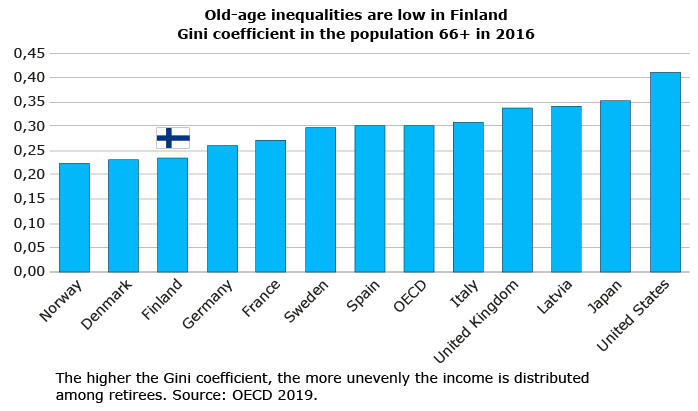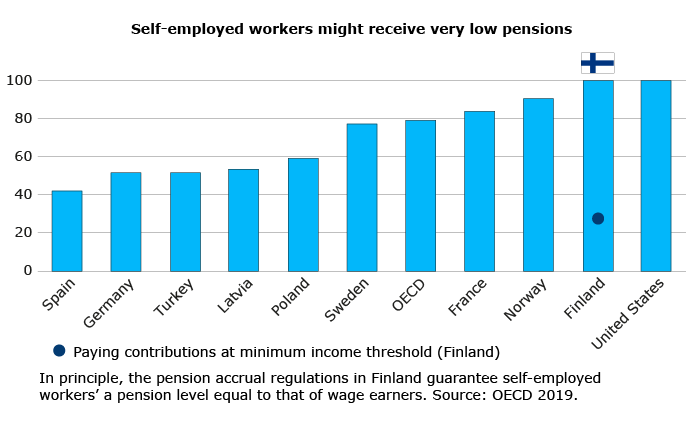International comparison: Finland stands out with its low old-age income inequalities

In its recent review, the OECD compliments Finland for its low old-age income inequalities. However, the OECD also expresses a concern for the low pension adequacy of the self-employed and suggests measures to improve their pensions. Pension levels in relation to earnings will be reduced in the future in most OECD countries, also in Finland.
At the moment, according to the OECD report, the income of Finnish citizens who have turned 65 years is 17 per cent lower than that of the total population. The average gap in OECD countries is 13 per cent.
Finland has succeeded better than average to prevent old-age income inequality. The OECD measures old-age income inequality with the Gini coefficient, the most common indicator describing income inequality. The Gini coefficient for Finnish retirement-aged citizens is 0.23. The average Gini coefficient for OECD countries is 0.30, which is one-third higher than Finland’s. Income inequality is higher in, for example, France and Sweden, than in Finland.

The Gini coefficient for retirees has slightly risen in the last decades in Finland. The change is due to growing income gaps on the labour markets.
“Pension income is based on the income earned during working life. Despite this, the old-age income inequality is comparatively low in Finland. The Finnish pension system has successfully combined the earnings principle with the goals of income distribution,” says director Jaakko Kiander (Finnish Centre for Pensions).
Replacement rate of pensions in OECD top third
The replacement rate of pensions is decreasing in most OECD countries due to pension reforms. The replacement rate depicts the ratio between the pension and the pre-retirement wage income.
The OECD estimates that 22-year-old Finnish citizens get a net pension that is 64 per cent of the pre-retirement wage, assuming they entered working life in 2018 and work in the private sector with an average wage until reaching their retirement age of 68. The average replacement rate in OECD countries will be lower (59 per cent).
The OECD estimates that, in terms of the replacement rate, Finland will be among the top third OECD countries in the future. Finland’s replacement rate will be reduced by 4 per cent from its current level. The average rate for OECD countries will be reduced by 6 per cent.
“Many countries have prepared for increasing longevity with mechanisms like the life expectancy coefficient. Considering OECD’s data, the Finnish coefficient’s reducing effect on future pensions seems smaller in Finland than in other industrial countries on average,” Kiander explains.
OECD recommends reform of self-employed workers’ pensions
In its report, the OECD also raises concern about the adequacy of self-employed workers’ pensions. OECD is critical towards the possibilities of a self-employed worker to set their confirmed income that forms the basis of the pension insurance which, in turn, defines the pension contribution of the self-employed person.
If the earnings of a Finnish self-employed worker correspond to the average wage level, but the self-employed sets their confirmed income at the minimum level, their pension will amount to only 27 per cent of the average wage earner’s pension. In OECD countries, the average pension of self-employed workers is 79 per cent of that of wage-earners.
OECD recommends that Finland monitors how the setting of the confirmed income develops and reforms the basis of the pension contribution for the self-employed. In the future, the pension contributions of the self-employed could be based not on the confirmed income but on the income in the tax report.
The lower limit of the confirmed annual income of the self-employed in Finland is currently 7,958.99 euros. In addition to the pension amount, the self-employed worker’s daily allowance under health insurance and the compensation under voluntary worker’s occupational insurance are determined based on the confirmed income. The confirmed income also affects the self-employed worker’s unemployment benefit and income during maternity or paternity leave.

More about the subject at the research seminar at the Finnish Centre for Pensions on 4 February
Hervé Boulhol (leader of the Pensions and Population Ageing team in the Directorate for Employment, Labour and Social Affairs, OECD) and Maciej Lis (Economist at the OECD) will present the fresh international Pensions at a Glance report at the research seminar of the Finnish Centre for Pensions on 4 February. The review How does Finland compare? will also be discussed at the event. What is Finland’s current situation, and what will it be in the future?
The other speakers at the event include professors Karl Hinrichs (University of Bremen) and Bernhard Ebbinghaus (University of Oxford). They outline the directions and consequences of European pension reforms in light of fresh research findings. Comments by professors Seija Ilmakunnas (University of Jyväskylä) and Traute Meyer (University of Southampton).
Participating in the discussion will also be Suvi-Anne Siimes (Finnish Pension Alliance Tela), Teemu Muhonen (Helsingin Sanomat), Ilkka Kaukoranta (The Central Organisation of Finnish Trade Unions SAK), Hannu Ijäs (Ministry of Social Affairs and Health) and Elisa Gebhard (The Finnish National Youth Council Allianssi).
More information
- Kati Kuitto, Senior Researcher, phone +358 29 411 2479, kati.kuitto(at)etk.fi
- Jaakko Kiander, Director, research and statistics, phone +358 29 411 2414, jaakko.kiander(at)etk.fi
- Pension reforms, non-standard work and life course inequalities in the OECD – ETK Research Seminar 4.2., #ETKseminaari
- OECD: Pensions at Glance, How does Finland compare (Country specific findings, pdf)
- Työeläke.fi: Self-employed – Don’t underinsure yourself